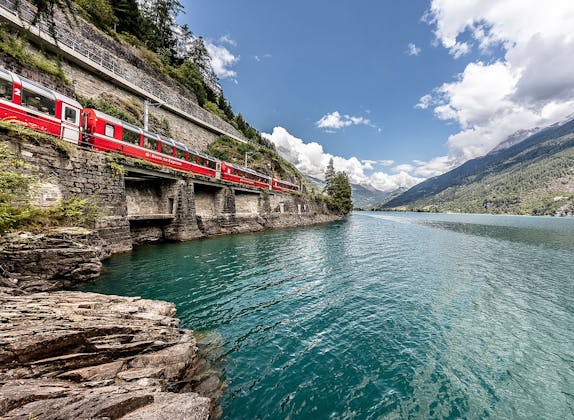
Swiss Travel Pass
Validity: All day

If you’re looking for the perfect itinerary for your six days in Switzerland trip, this selection of 9 itineraries will help you plan your trip. It shows you different options that are all doable in six days from Zurich. All of the following itineraries are also adaptable so that you can start along the way or in a different city.
Even though Switzerland is small, there’s more than enough to see and do in six days. If you’re planning your trip to Switzerland, the following itineraries will be helpful.
All of them can be completed in six days and start from Zurich. However, if you’d like to begin your journey from a different location, you can easily adjust your trip accordingly. Zurich is very well connected and can be reached from any other city in Switzerland.
Some itineraries end in Geneva or pass through cities close to Geneva. So if you’re planning to arrive from the west of Switzerland, you can easily tailor the itinerary to your preferences. For instance, there’s a route that starts in Zurich and passes through Lausanne. If you’re starting in Geneva, you can simply begin that itinerary in Lausanne, which is just a half hour train ride away.
You’ll notice I only talk about traveling by public transport and not by car. Most routes can also be taken by car if you’d like to rent one during your stay in Switzerland. But with our very dense network of trains and buses, traveling by car is actually not necessary.
If you have more than six days and see a route you like, you can easily extend it by spending an extra night in some places.
Have fun planning!
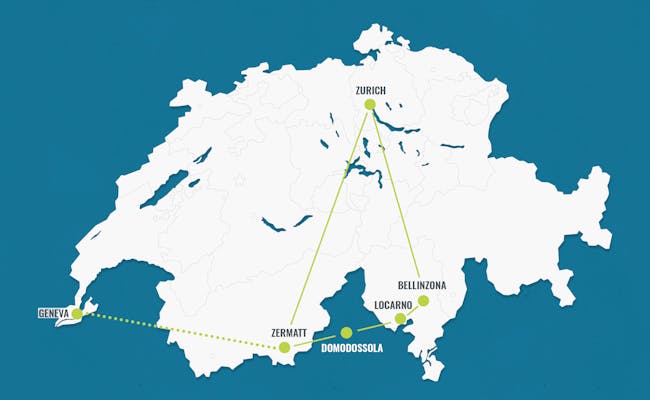
Highlights in this itinerary:
Explore Zürich on your own in the morning, rent a free bike with "Züri rollt" or join a city tour. After the tour, grab a take-away lunch and take the train to Bellinzona.
Thanks to the 57 km long Gotthard Base Tunnel, it now takes you less than two hours to zoom through the Alps and reach the warm southern part of Switzerland.
Make a stop in Bellinzona to visit the Castello di Montebello, a UNESCO World Heritage site, before continuing on to Locarno.
Spend the rest of the evening soaking in the Italian atmosphere in Locarno. Hang out at Piazza Grande, stroll along Lago Maggiore, or treat yourself to some ice cream by the lake. And just in case you’re wondering: yes, you’re still in Switzerland, even if it feels more like Italy.
As you'll be spending the next three nights in Ticino, you’re entitled to the fantastic Ticino Ticket. You’ll receive it when you check in at your accommodation.
This handy guest card allows you to use public transport throughout Ticino for free. Plus, you’ll get numerous discounts at other attractions and activities.


Get ready to explore the Italian part of Switzerland in all its glory. With so many activities to choose from, you won't be bored today.
First, I recommend heading to one of the two river valleys: Maggia or Verzasca. Both are perfect for hiking, spending time by the river, or taking a refreshing dip. Don’t forget to pack your picnic! Both valleys offer countless spots to take a break. My favorite place is right under the famous stone bridge in Lavertezzo.
If you prefer calmer waters to the cold mountain streams, you should head to Lake Maggiore or Lake Lugano. Both lakes are stunning and offer more photo opportunities than you can imagine.
Other popular destinations in Ticino include the inspiring art town of Ascona near Locarno and the city of Lugano further south.
If you want to brush up on your knowledge of Swiss geography, visit Swissminiatur in Melide just outside Lugano. It’s a miniature version of Switzerland and displays incredible attention to detail.
If you’re an adrenaline junkie, check out the 007 Bungy jump at the end of the Verzasca Valley. You might have seen this 220-meter jump in the James Bond film GoldenEye. If you decide to take the plunge, don’t forget to share your photo with us. We’d love to see it… 🙂
As you may have noticed, this day is far from long enough to get through everything on the list. Good thing there’s always tomorrow.
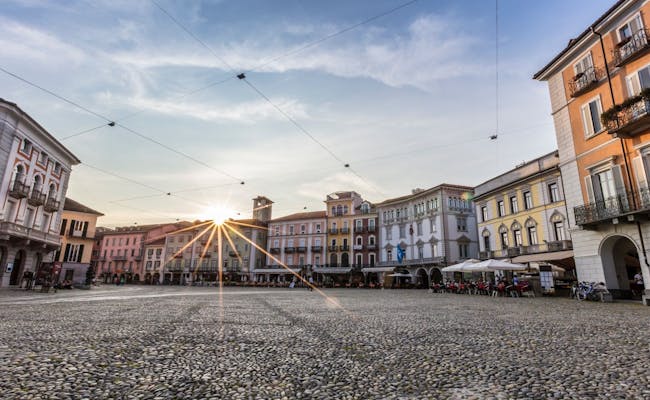
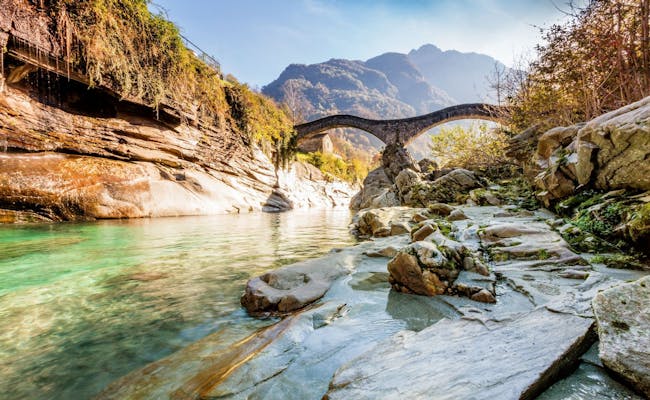
Knock yourself out doing whatever you missed out on yesterday. The list should be long enough to keep you busy for another day.
Not far from Lugano lies the idyllic Como region, the place where George Clooney and other celebrities got married. If you’re curious to find out what Mr. Nespresso saw in this part of the world, today’s your chance.
The two main places I recommend visiting in the area are the city of Como and the village of Menaggio. Both are situated by the shores of Lake Como and will automatically make you take a step back and enjoy the laid-back atmosphere.
At the end of the day, head back to Switzerland and spend whatever time you have left hanging out in Locarno before moving on to Zermatt tomorrow.
You’re probably going to laugh now. But the station your train to Domodossola leaves from is called Locarno FART. Unfortunate name, I know. It’s short for Ferrovie Autolinee Regionali Ticinesi and translates to “regional railway of Ticino”.
The ride to Domodossola lasts just under two hours. It might be the slowest train you’ve ever been on but chances are you won’t even notice time passing by.
The landscape is beyond stunning from start to finish. As you travel through the impressive Centovalli region – which stands for one hundred valleys – you’ll pass several charming villages with old stone houses, ride across tall viaducts and even catch a glimpse of a waterfall or two.
Enjoy the views because from Domodossola to Brig, you’ll be spending most of the time in a tunnel. That’s ok though because the ride from Brig to Zermatt is part of the Glacier Express – another scenic train ride.
Once you arrive in Zermatt, spend the rest of the day strolling through this little town and enjoy the sight of the mighty Matterhorn. Provided it’s not veiled in clouds.

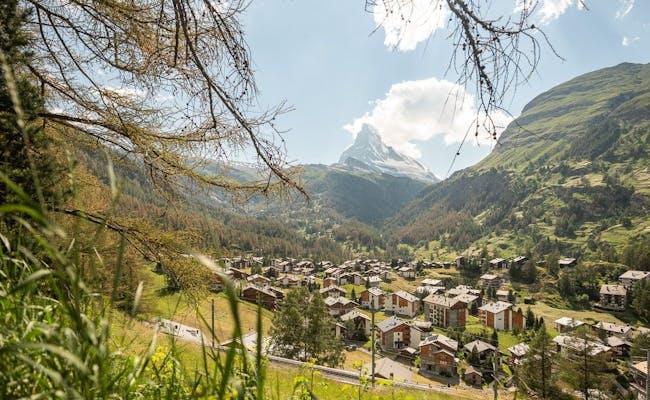
In Zermatt, the mountain world and nature take center stage. If you've come to Switzerland for the spectacular mountain views, you'll love it here.
Numerous hikes and walks of all difficulty levels take you to places you didn't even know existed. For example, the popular Zermatt 5-Lakes Trail, which takes about 2.5 hours. It passes five crystal-clear mountain lakes and offers breathtaking views of the Matterhorn along the way.
Another adventure that might make you feel a bit dizzy is crossing the longest pedestrian suspension bridge in the world in Randa. It's a full 494 m long and spans across the valley. The circular route to the bridge starts and ends in Randa, just 15 minutes by train from Zermatt.
If you'd rather skip the hike and see the mountains easily, I recommend taking the train up to Gornergrat. After an incredibly steep train ride, you'll find yourself at an altitude of 3,089 m above sea level, right in front of the Gorner Glacier and the Matterhorn. Don't be surprised if you find yourself out of breath climbing the stairs to the viewpoint; it's not you, it's the thin air.
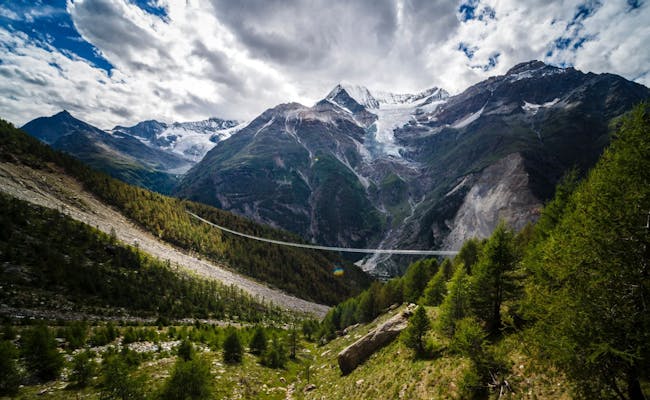
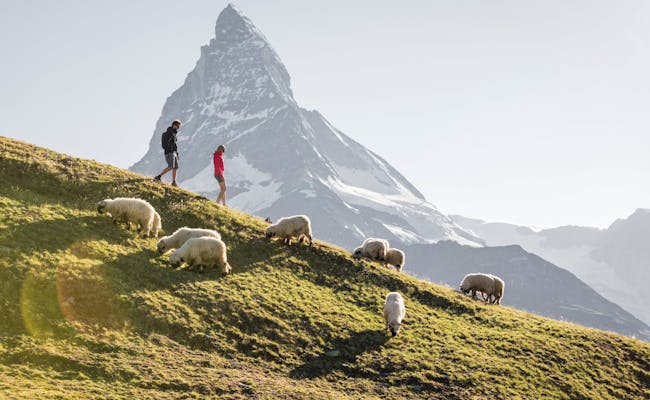
There’s certainly more than one day’s worth of things to do and see in Zermatt. Which means today is the perfect time to tick off anything you didn’t get round to yesterday.
Once you’re ready to leave the alpine air, catch the train back to Zurich. Or, if you’re flying out of Geneva or planning on visiting Switzerland’s second largest city, you can head in that direction instead.
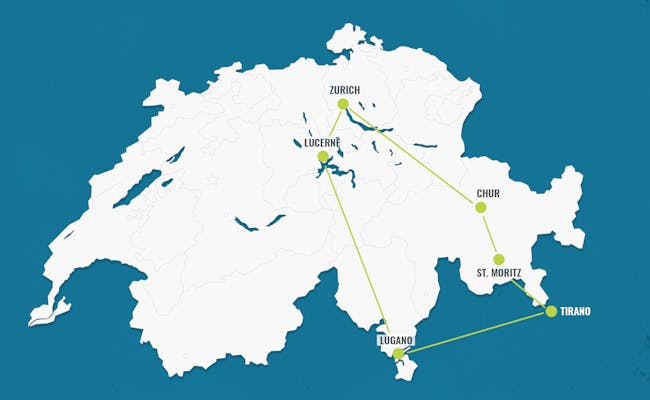
Highlights on this itinerary:
Explore Zürich on your own in the morning, rent a free bicycle with "Züri rollt," or join a city tour. After the tour, grab a takeaway lunch and enjoy it on the train to Chur.
To get a better view of Zürich and Lake Walen on your way to Chur, I recommend snagging a seat on the left side of the train.
Spend an hour or two wandering around Chur and get ready for the fresh mountain air that awaits you in St. Moritz. To get to St. Moritz, take the direct RhB train from Chur. Keep your camera ready because you'll be treated to panoramic views from start to finish. The Landwasser Viaduct and the winding Albula Line are two highlights along this route.
Spend the rest of the day in St. Moritz. If you’re feeling unusually sleepy this evening, it’s thanks to the altitude of 1822 m above sea level. Usually, it takes a day or two to get used to the thinner air.


Today you’ll spend several hours crossing the Alps from St. Moritz to Lugano. Your journey takes you up to the highest point of the Bernina Express line, passing sparkling glaciers and crystal-clear mountain lakes, down into the southern part of Switzerland and across a spectacular viaduct before you enter Italy.
And finally back into Switzerland…
The first leg of this train ride takes you to Ospizio Bernina, the highest point of the day’s journey. This small station is not far from St. Moritz and sits at 2,253 m above sea level. From here, it's all downhill. Well, figuratively speaking. On your way down to Italy, you’ll cross the circular viaduct in Brusio. Here, the train makes a complete 360-degree turn to gain height.
By this point, you’ve already lost quite a bit of elevation, and the outside temperature is much warmer than just a few hours ago. The last leg of the journey starts in Tirano, right at the Swiss-Italian border. From Tirano, the Bernina Express bus takes you through the stunning wine region of Valtellina.
Before you return to Switzerland, you’ll pass by Lake Como. The place where George Clooney and many other celebrities have tied the knot.
After this long day, you can stretch your legs along the promenade of Lake Lugano. Enjoy the view, grab a few scoops of ice cream, and stroll through Lugano.
You’ve earned it.


Since you’ll be spending the next two nights in the canton of Ticino, you're entitled to the fantastic Ticino Ticket. You’ll receive it when you check in at your accommodation.
With this handy guest card, you can use public transportation all over Ticino for free. Plus, you'll get numerous discounts at various attractions and activities.
If you want to know what to do in the area, take another look at Day 2 of Itinerary No. 1. You'll find activities listed for about three days there. That should keep you busy for a while.
Alternatively, you can leave Switzerland and cross the border into Italy. Not far from Lugano, you’ll find the picturesque Lake Como region, where George Clooney and other celebrities have tied the knot. If you’re curious about what Mr. Nespresso has seen in this part of the world, today’s your chance.
The two most beautiful spots in the region that I recommend are the city of Como and the village of Menaggio. Both are situated along the shores of Lake Como and will charm you. At the end of the day, you’ll head back to Switzerland and spend the remaining time in Lugano.
If you're visiting Switzerland between April and October, you're in luck. As long as you don’t leave Ticino on a Monday, you have the chance to travel back over the Alps on the Gotthard Panorama Express.
On the first leg of this journey, a panoramic train takes you through the historic Gotthard Tunnel to Flüelen. Before the Gotthard Base Tunnel opened in 2016, this was the only way to reach Ticino by train. Now, since the world’s longest tunnel has opened, the old tunnel is only used for tourist purposes.
In Flüelen, you’ll enjoy a three-hour scenic boat ride across Lake Lucerne. You’ll arrive in Lucerne around 3:00 PM, right next to the train station. This gives you plenty of time to explore this charming city and its surroundings. If you can’t take the Gotthard Panorama Express to Lucerne, just hop on a regular train instead.

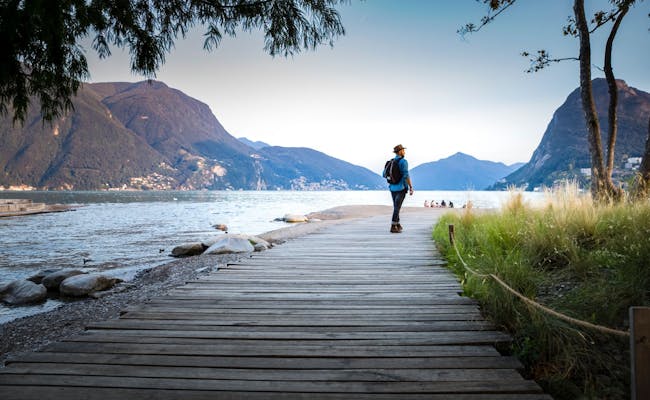
Lucerne has so much to offer. One of the most exciting excursions is taking the steepest cogwheel train in the world up to Pilatus, the local mountain of Lucerne. This train only operates in summer from Alpnachstad, while the cable car from Kriens operates year-round to Pilatus.
Speaking of mountains: Titlis is another landmark in the region worth a visit. You can reach the summit from Engelberg using two gondolas. One of them is the world's first rotating aerial cable car. You'll be treated to an impressive 360-degree view.
If you're up for a light hike that includes a ride on a 152.8 m high rocket-like lift, you can take a boat or bus to Kehrsiten-Bürgenstock.
Don't forget about Stanserhorn, a mountain near Lucerne, which you can reach using a modern double-decker cable car. The best way is to take a boat to Stansstad. Here, you'll switch to the funicular for the first leg and then take an open-air gondola for the final stretch to Stanserhorn.
If you're feeling adventurous, you could theoretically head to Interlaken for the day. Leave Lucerne in the morning on the Golden Pass Line, spend your day exploring the picturesque region around Interlaken, and return to Lucerne in the evening.
Another fantastic way to spend the day around Lucerne is by taking a boat ride on Lake Lucerne. Several steamers and passenger ships operate on the lake to take you on a scenic excursion.
As you can see, Lucerne has plenty to offer on a sunny day. But in reality, the weather isn't always so promising. In that case, we've got some cool indoor options for you.
For starters, there's Aeschbach's Chocoworld in Root. The bus ride there takes about 30 minutes. Nothing brightens a rainy day quite like delicious chocolate, right?
In Hergiswil, not far from Lucerne, you'll find what the Swiss affectionately call the "Glasi." The Hergiswil Glassworks takes you through the glass-making process, lets you watch the professionals at work, and even gives you a chance to try glassblowing yourself. When was the last time you made your own glass?
Another option for inclement weather is the Swiss Transport Museum in Lucerne. As the name suggests, this museum is all about modes of transportation. From bicycles to astronautics, it covers everything.


Luckily, you don’t have to leave Lucerne until the afternoon or even evening today. So spend the day doing whatever you didn’t get to do yesterday. You can also explore the city on your own, walk across the Kapellbrücke, visit the Glacier Garden with its famous Lion Monument or join a guided city tour.
Another popular pastime near Lucerne is heading up to Mount Rigi. To find out exactly how to get to the Queen of the Mountains and make most of this excursion, turn to itinerary No. 3 on day 2.
Toward the end of the day, catch the train back to Zurich and spend the rest of the day exploring Switzerland’s largest city.
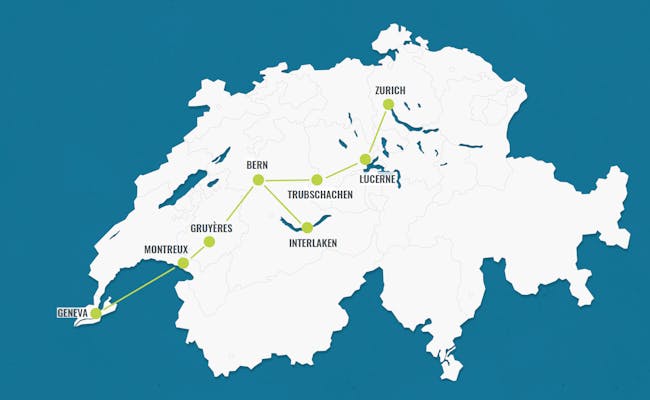
Highlights on this itinerary:
Start your day in Zürich and take the train to Lucerne. Store your luggage either at the train station or in your accommodation, then catch the next train to Arth Goldau. From there, the cogwheel train will take you on a 45-minute journey to the summit station Rigi Kulm, which is the first mountain railway in Europe.
If the Rigi isn't covered in clouds, you'll be treated to breathtaking views of the Alps, Lake Lucerne, and other surrounding lakes. Simply follow the signs to the viewpoint after getting off at Rigi Kulm.
Once you've captured enough photos, you can either take a break at the restaurant, ride the train down to Vitznau, or go for a hike. With over 120 kilometers of hiking trails, you have plenty of options to choose from.
Upon arriving in Vitznau, the passenger ship to Lucerne will be waiting for you. Keep your camera ready, as the ride is incredibly scenic and offers even more stunning views.
Back in Lucerne, you can spend the rest of the evening exploring the city or find a cozy spot by the lake to unwind.
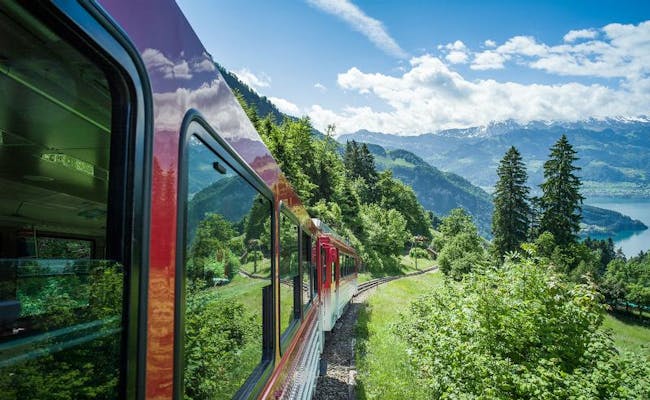
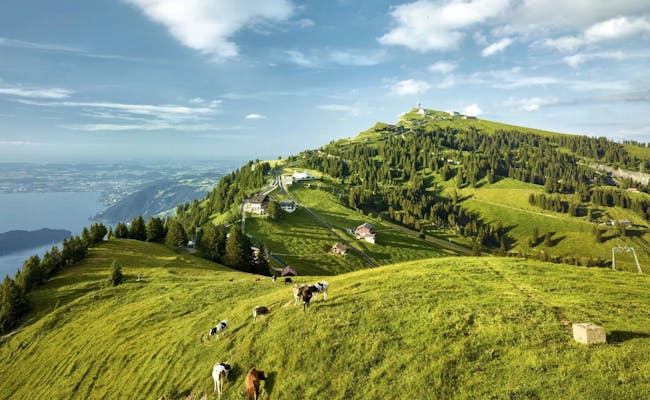
Lucerne has so much to offer. One of the most exciting excursions is taking the steepest cogwheel train in the world up to Pilatus, the local mountain of Lucerne. This train only runs in the summer from Alpnachstad, while the cable car from Kriens takes you to Pilatus year-round.
Speaking of mountains: Titlis is another landmark in the region worth visiting. From Engelberg, you reach the summit using two gondolas. One of them is the world's first rotating aerial cable car. So, you can expect an impressive 360-degree view.
If you're up for an easy hike that includes a ride on a rocket-like elevator 152.8 meters high, you can take a boat or bus to Kehrsiten-Bürgenstock.
Don’t forget about Stanserhorn, a mountain near Lucerne that you can reach via a modern double-decker cable car. It's best to take the boat to Stansstad. From there, you switch to the funicular for the first leg and ride the outdoor gondola for the last stretch to Stanserhorn.
Theoretically, you could also head to Interlaken on this free day. Leave Lucerne in the morning on the Golden Pass Line, spend the day exploring the photogenic area around Interlaken, and return to Lucerne in the evening.
Another great way to spend the day around Lucerne is to take a trip on Lake Lucerne. Several steam and passenger ships operate on the lake, offering a scenic outing.
As you can see, Lucerne has plenty to offer on a sunny day. However, in reality, the weather isn't always so promising. In that case, we’ve got some cool indoor options for you.
For starters, there's Aeschbach's Chocoworld in Root. The bus ride takes about 30 minutes. Nothing brightens up a rainy day quite like delicious chocolate, right?
In Hergiswil, not far from Lucerne, you'll find what the Swiss lovingly call the "Glasi." The Hergiswil glassworks takes you through the glass-making process, lets you watch the professionals at work, and even gives you a chance to try your hand at glassblowing. When was the last time you made your own piece of glass?
Another option for bad weather is the Swiss Transport Museum in Lucerne. As the name suggests, this museum covers all forms of transport. From bicycles to astronautics, it has it all.

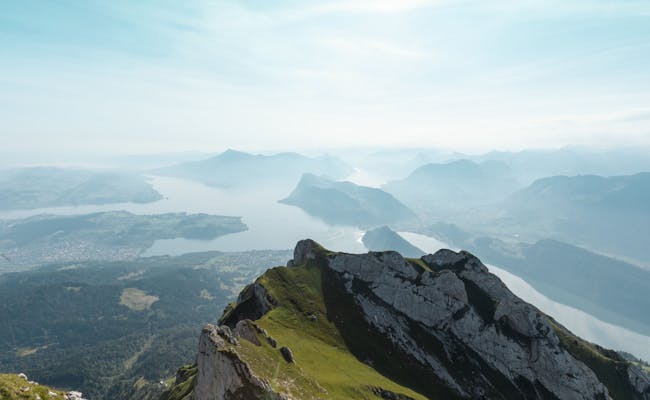
Luckily, you don’t have to leave Lucerne until lunchtime today. So spend the morning doing whatever you didn’t get to do yesterday.
Alternatively, you can also explore the city on your own, walk across the Kapellbrücke, visit the Glacier Garden with its famous Lion Monument or join a free walking tour.
Whatever you do, make sure you work up an appetite and don’t grab too big a lunch for your ride to Trubschachen. You’ll need every free inch in your stomach for the biscuit feast awaiting you...
The train to Trubschachen gets split up along the way and only the front part travels through the picturesque Entlebuch region to your culinary destination. When you’re at the platform in Lucerne, please check the display to make sure you get on the right half of the train.
The Kambly factory store right next to Trubschachen station is free to visit. In here, you can spend as much time as you like tasting up to 100 types of delicious biscuits. Unfortunately, you can’t visit the factory and watch the production of this iconic Swiss biscuit. However, they do have a cinema at the shop where they give you some more insight into this traditional family business.
After reaching the point of explosion, or maybe two biscuits before, move on to Bern. To digest your Kambly overdose, go for a walk in Switzerland’s capital city. For an impressive night view over Bern, I recommend heading up to Rosengarten.


Today, you're heading out on a day trip to one of Switzerland's most popular destinations. Interlaken is practically a must-see for anyone visiting Switzerland. While there are many other places with breathtaking views and perfect hiking opportunities, you won't find a spot as geared towards tourists as Interlaken.
You can find a detailed list of activities in and around Interlaken on Day 2 of Itinerary No. 5, where I've compiled around three days' worth of things to do. That should keep you busy for a while.
If you leave Bern early in the morning, you'll have plenty of time to catch the passenger boat to Interlaken from Thun. This boat ride takes just over two hours and will most likely take your breath away.
You’ll pass charming villages and towering mountains as you cross Lake Thun, arriving in Interlaken. This is probably one of the most beautiful boat rides in Switzerland. And even if the weather isn’t perfect, it’s a mystical experience worth getting out of bed for.
Moreover, the trip is fully covered with an Interrail, Eurail, or Swiss Travel Pass. Don’t miss out on this opportunity...
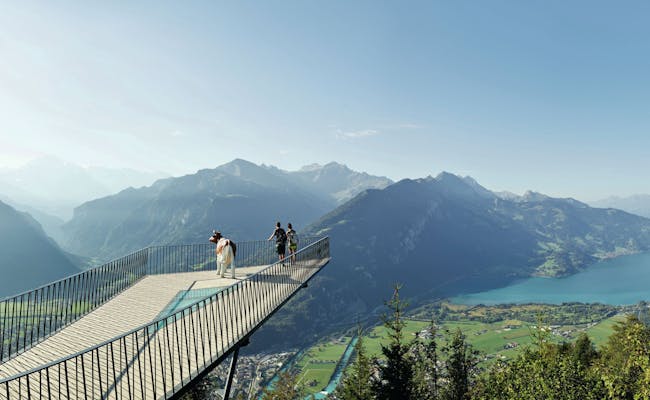

After breakfast, you’ll have some time to further explore Bern. Join a city tour or discover Bern on your own. Stroll through the old town, visit the Bear Park, check out the Federal Palace, and walk back to the Rose Garden to enjoy the view.
You can also visit the Gurten - Bern’s local mountain, observe animals at the Dählhölzli zoo, or visit the Botanical Garden. Take the lift at the train station and enjoy the view from the Grosse Schanze, or go for a swim in the Aare or at Weyermannshaus.
It’s clear that half a day won’t be enough to do all these activities. But since Montreux has a lot to offer as well, I recommend leaving Bern around noon. Grab a take-away lunch to enjoy on the train to Montreux. This way, you save time and can spend the entire afternoon in Montreux.
Once you’ve dropped off your luggage at your accommodation in Montreux, head to the promenade to see the Freddie Mercury statue in front of the market hall. If you want to visit the famous Chillon Castle, you can follow the promenade to the castle or take the bus. Passenger boats also regularly ferry between Montreux and Chillon Castle.
Alternatively, you can take a trip in the other direction to the Lavaux vineyards. Just a short train ride west of Montreux, you’ll find the famous Lavaux vineyards, which are a UNESCO World Heritage site. To enjoy the stunning views, get off in Cully or Epesses and follow the marked hiking trail through the vines.
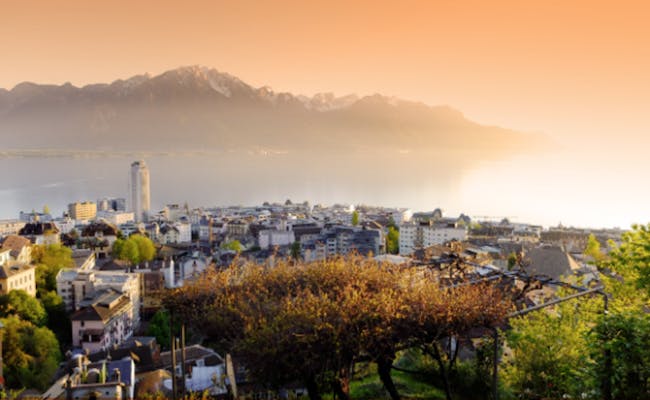
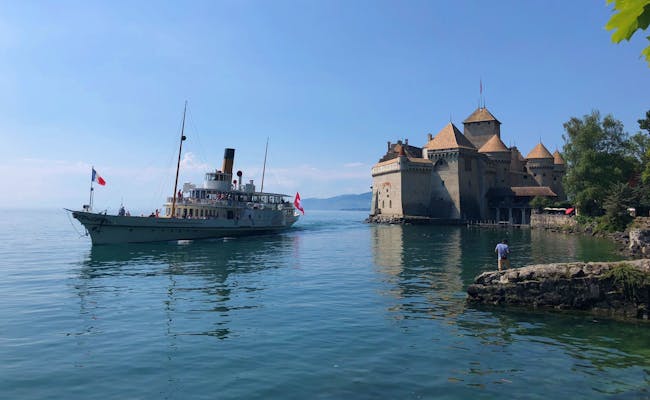
Today is all about cheese and chocolate. After all, Switzerland is famous for them. So hop on the train to Gruyères and get ready for a feast in a medieval town.
The Gruyère cheese factory is right behind the train station. Here, you can watch how the traditional Gruyère cheese is made. Of course, tastings are included. Once you’re done snacking, you can take the bus or follow the path to the center of Gruyères. This walk will take you about 20 minutes.
The main attraction in Gruyères is probably the castle, which is open to the public and costs 12 CHF for entry. However, the hidden cobblestone streets and numerous souvenir shops might tempt you to stay longer than you expected.
After exploring Gruyères and maybe picking up a souvenir or two, you can head to Broc to visit La Maison Cailler. In their visitor center, you’ll learn everything you need to know about the oldest chocolate brand in Switzerland. At the end of the tour, you’ll be treated to a buffet where you can sample plenty of chocolate.
On the train ride back to Montreux and then on to Geneva, you might want to digest your cheese and chocolate overload. Spend the rest of the day in Geneva and explore the second largest city in Switzerland.
You also have the option to trade in your cheese and chocolate high for a glacier visit. Instead of heading to Gruyères, you can take the train to Col-du-Pillon and visit Glacier 3000.
The 360-degree views are breathtaking. And if you’re brave enough, the Peak Walk over the suspension bridge is an experience you won’t forget anytime soon.
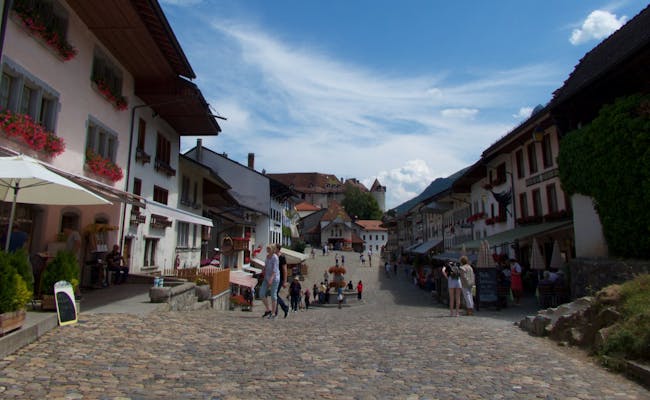
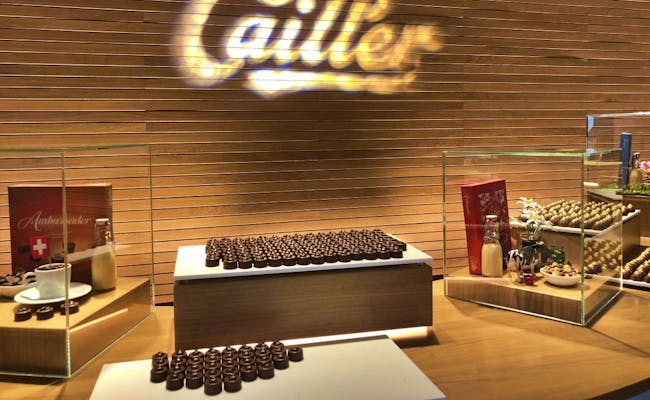

Highlights on this itinerary:
Explore Zürich in the morning at your own pace. You can rent a free bike with «Züri rollt» or join a city tour. After the tour, grab a take-away lunch and take the train to St. Gallen.
Spend the afternoon wandering around the old town of St. Gallen. With its UNESCO-listed Abbey District, the stunning cathedral, and the impressive Abbey Library, this city has plenty to offer.
Don’t miss the recreational area “Drei Weieren.” You can reach it either by taking the Mühleggbahn or walking up one of the many staircases. Alternatively, you can visit the Peter & Paul wildlife park or quench your cultural thirst in one of the many museums.
The best place to relax is definitely at “Drei Weieren.” Here, you can go swimming or take a walk through the woods. Plus, you get a fantastic view over the entire city, Lake Constance, and even all the way to Germany.

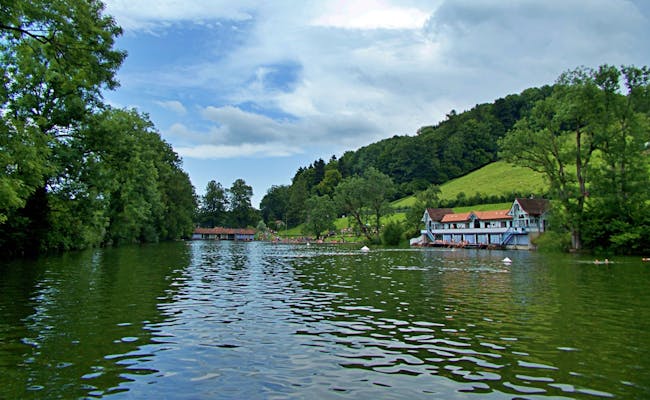
The following two days are fully dedicated to exploring the Alpstein mountain range. Leave whatever luggage you won’t need in St. Gallen and get ready for some serious hiking.
The hiking options are absolutely endless in this mountain range. Whether you’d like to catch a glimpse of the famous Äscher restaurant or go for a swim in the charming Seealpsee, you’ll find your match.
Since you’ve got two days to spare, I’ll run you through one of my favourite hikes in this area. It starts in Brülisau, includes two mountain lakes, some fresh milk and cheese, maybe a night in a stable above the cows and definitely a pair of sore calves.
Firstly, make your way to Brülisau in the Canton of Appenzell Innerrhoden. From here, start your walk to the restaurant Ruhesitz, which you’ll reach halfway up a mountain called Hoher Kasten. From Ruhesitz, follow the signs pointing you toward Lake Sämtisersee. By now, you might be ready for a break. Spend as much time as you like hanging out by or inside this beauty.
From Sämtisersee, keep going until you reach Bollenwees by Lake Fälensee. If you’re looking for comfort, this mountain inn is where you can spend the night. They offer private rooms or dorms with showers as well as a restaurant. The views over the lake are unparalleled and after this long day of hiking, you’ll probably be more than happy to just stretch your legs and take in the stunning backdrop.
However, if you’re up for a bit of an adventure, keep going. Follow Lake Fälensee to the end and you’ll bump into Fälenalp, a little Alp where a farmer’s family takes their cows, goats and pigs to spend the summer. They offer beds in a big dorm in a stable above the cows and cook a rustic farmers’ dinner for you.
Everyone looking for a place to forget about this busy world out there will love coming here. In case you decide to stay at Bollenwees, I still recommend you walk to Fälenalp to see this magical place and to try their fresh goat cheese. Either today after settling in at Bollenwees or tomorrow before heading back to St. Gallen.
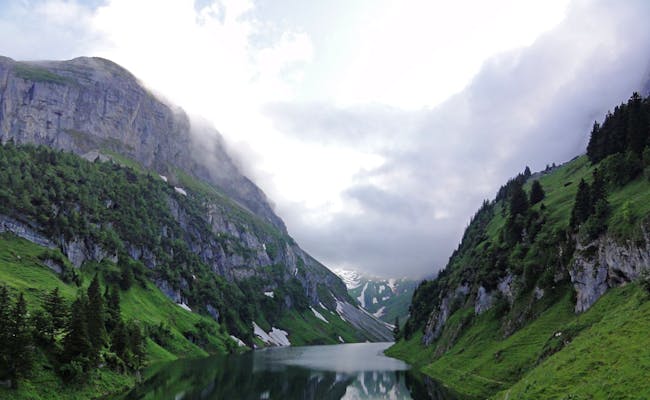
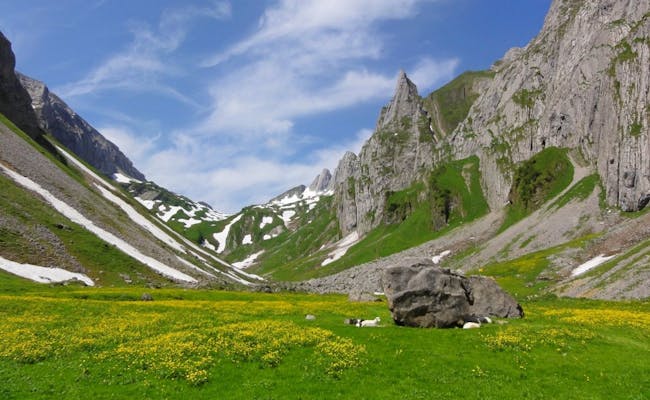
Wherever you spent last night, I hope you slept well in this fresh mountain air. I usually head straight home after breakfast, but it’s really up to you how you plan out your day. You haven’t exhausted your hiking options by far, so keep going for as long as you please.
One option is to climb to Bogartenmannli and terminate your hike in Wasserauen after passing Seealpsee. This should put you on the train to St. Gallen some time in the afternoon. Or you can just walk back to Brülisau via Sämtisersee and Brüeltobel. The world is your oyster here.
On your way back to St. Gallen, you might like a quick stopover in Appenzell, the charming capital of the Canton of Appenzell Innerrhoden. In case you’re feeling brave, visit the little cheese store at Hauptgasse 13. But be warned, those smelly cheese fumes will knock your socks off the second you enter the store.
There’s no way your feet will be able to compete with that odour. Not even after two full days of being trapped inside your trekking boots... 🙂
Oh, and don’t miss out on a piece of Appenzeller Biber, an iconic local sweet treat made of gingerbread and a honey almond filling. And before you ask: Nope. This Biber doesn’t have any famous Canadian relatives...
Also, if you’re a beer-lover, make sure to stop by the Locher brewery. They brew the popular Quöllfrisch beer that is consumed all across Switzerland.
In the evening, head back to St. Gallen and enjoy sleeping like a baby tonight. Spending a day or two in the mountains has a tendency to leave you peacefully exhausted.


I’d say it’s time to take it down a notch today. After two intense and possibly exhausting days in the Alpstein, take a relaxing trip to Lake Constance.
This lake is 63 kilometres (39 miles) long, up to 14 kilometres (8.7 miles) wide and shares its shores with Germany, Austria and Switzerland. It’s one of Europe’s biggest lakes and is very easy to reach from St. Gallen by train.
This tri-national area offers a considerable amount of sights and activities for you to discover. For one, there’s the picturesque town of Constance in Germany that’s just within walking distance from Kreuzlingen. Most Swiss go there for its cheap shopping, but Constance has more to offer than low-priced stores.
With its charming old town, a wide array of cafés, restaurants, ice cream places and peaceful spots to hang out by the lake, Constance certainly manages to attract visitors throughout the warmer months.
If you’re into fish and other creatures that live and dwell under water, the Sea Life is always a potential bad weather option.
Of course, you don’t need to leave the country to enjoy Lake Constance to its fullest. Visit one of the many beaches, go for a swim, catch a passenger ship, rent a stand up paddleboard, grab a bike and follow the trails or go for a walk along the lakeshore.
The Canton of Thurgau, which makes up most of the Swiss part along Lake Constance, is famous for its apple trees. One of the walks I recommend in this area is the Altnauer Apple Trail. It’s particularly idyllic when the trees bloom in April and May or then again during harvest time in autumn. The trail is basically divided into three separate trails, which all contain informative signs addressing different topics. Combine all three trails and you’ll know everything there is to know about apples. Oh, and options to buy and taste a selection of apple products are plentiful along the way, too.
Additional places of interest by Lake Constance are the towns of Romanshorn, Rorschach and Kreuzlingen. Once you’re done exploring the area, catch the train back to St. Gallen for one last night.


By now, you've probably seen enough of St. Gallen, so grab your luggage in the morning and hop on the Voralpen Express to Lucerne. The Voralpen Express passes through some truly picturesque landscapes and takes just over two hours to reach Lucerne.
Among the many scenic train rides in Switzerland, this one is notably less touristy. There are no large panoramic windows and no friendly voice telling you which viaduct you're currently crossing.
But that doesn't make the journey any less worthwhile.
I recommend taking a break midway and getting off in Rapperswil. This town is a hidden gem at the lower part of Lake Zurich. Visit the castle, spend some time with the deer in the castle garden, take a swim in Lake Zurich, and stroll along the idyllic lakeside promenade.
A great spot to relax is the meadow behind the OST, the University of Applied Sciences in Rapperswil. You can't miss it if you head towards the lake from the train station.
If you want to take a nice walk, follow the wooden walkway and the connecting path over the lake to Pfäffikon. This will take you along three kilometers of the Camino de Santiago, a pilgrimage route leading from various places in Europe to Santiago de Compostela in Spain.
Once you're ready to continue, hop on the next train to Lucerne and spend the afternoon exploring the city. Walk across the Chapel Bridge, wander through the old town, linger by the lake, or visit the Glacier Garden with the famous Lion Monument.
You can find a detailed list of activities in Lucerne on Day 2 of Route No. 3.
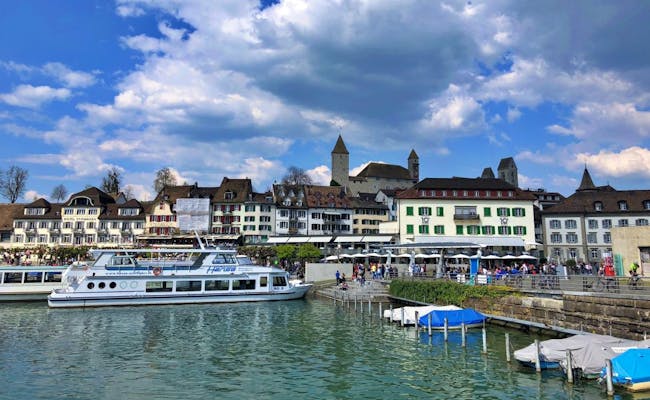
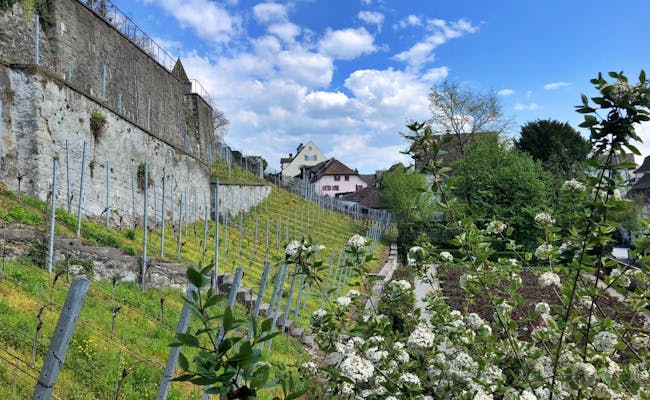
Luckily, you don't have to rush today and can enjoy Lucerne until the afternoon or even the evening. You have plenty of time to catch up on everything you didn't get to yesterday.
A popular day trip from Lucerne is a visit to Mount Rigi. To get there, you can either leave your luggage at your accommodation in Lucerne or at the train station and take the train to Arth Goldau. From there, the Rigi Bahn - the first mountain railway in Europe - will take you to the Rigi Kulm summit in a 45-minute ride.
If Mount Rigi isn't covered in clouds, you'll have a spectacular view of the Alps, Lake Lucerne, and other surrounding lakes. Just follow the signs to the viewpoint after you get off at Rigi Kulm.
Once you've taken enough photos, you can either take a break at the restaurant, hop on the train down to Vitznau, or go for a hike. With over 120 kilometers of hiking trails, you've got plenty of options.
When you arrive in Vitznau, the passenger ship to Lucerne will be waiting for you. Keep your camera ready, as the ride is stunning and offers even more breathtaking views.
Back in Lucerne, you can collect your luggage and head back to Zurich.
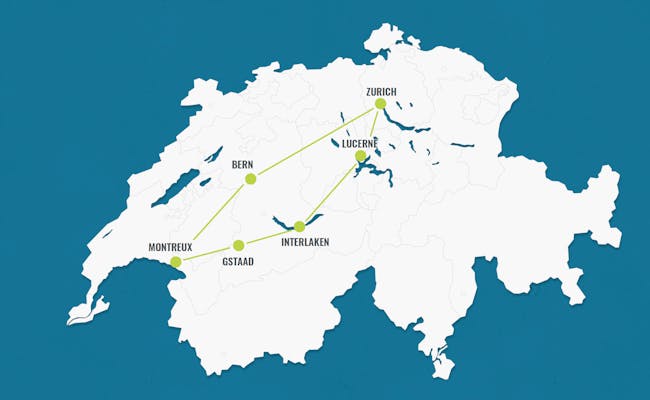
Highlights on this itinerary:
Leave Zürich early in the morning, head to Luzern, and spend a few hours exploring the city. Stroll across the Chapel Bridge, wander through the old town, relax by the lake, or visit the Glacier Garden. Continue your journey around lunchtime to Interlaken.
The Golden Pass Line is a popular scenic route from Luzern to Montreux, operated by several train companies. It connects the heart of Switzerland with the shores of Lake Geneva.
This panoramic route passes by eight lakes, travels through six different cantons, crosses three mountain passes, and connects two language regions. The leg from Luzern to Interlaken is operated by the Zentralbahn and takes just under two hours.
Upon arriving in Interlaken, you'll spend the evening in this popular and very touristy town. There are countless activities to enjoy. If you want to fully experience this region, one night might not be enough. However, there should be plenty of time for a walk along the Aare or a quick trip to Harder Kulm.

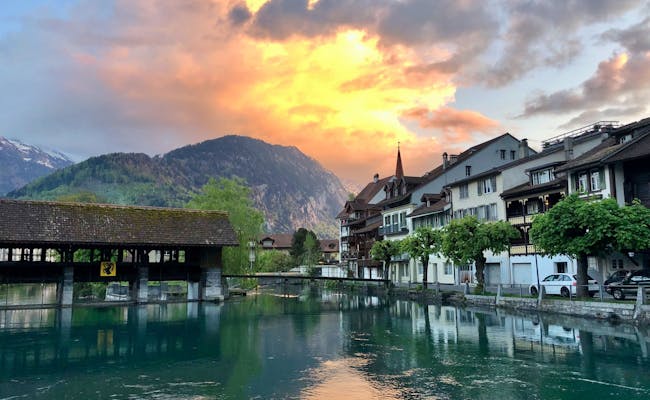
For the next two days, you'll have more activities to choose from than you can imagine. It all depends on your budget, but in Interlaken, the sky's the limit.
Or maybe even more!
Skydiving, paragliding, canyoning, and jet boating are popular activities that will get your adrenaline pumping.
A more relaxed option is a ride on a passenger ship on Lake Thun or Lake Brienz. On both lakes, you'll be treated to incredible views, making you wish you could stay forever. If you want to make a stop during one of the boat rides, you can get off at Giessbach (Lake Brienz), St. Beatus Caves, or Spiez (Lake Thun).
The Jungfrau region around Interlaken is also an excellent place for hikers. The number of hiking trails is virtually endless. No matter your fitness level or ambitions, you'll find something that suits your taste here.
Of course, the famous Jungfraujoch—also known as the Top of Europe—is the number 1 destination everyone wants to see. With the Jungfrau Railway, you’ll ride up to the highest railway station in Europe and find yourself surrounded by stunning mountain and glacier landscapes.
If you're looking for a more budget-friendly alternative to the Jungfraujoch, I recommend visiting the Schilthorn, Schynige Platte, Grindelwald First, or Männlichen instead. The rides to these mountains and the views from the summits won't disappoint.
Other attractions in and around Interlaken include the Ballenberg Open-Air Museum, the chocolate workshop at Funky Chocolate Club, the two mountain lakes Blausee or Oeschinensee, or the Aare Gorge. And let's not forget the charming towns and villages like Brienz, Spiez, Thun, Lauterbrunnen, or Grindelwald.
I could go on forever here. But I think you'd just get frustrated that you can't spend the whole week here.

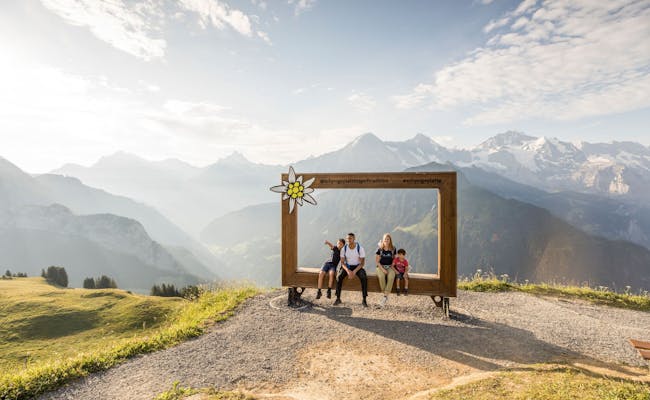
Today, you can look forward to another scenic treat. Once you leave Interlaken heading towards Zweisimmen, you'll have Lake Thun on your right. For the best view of the lake, I recommend snagging a seat on the right side of the train.
After just over an hour of travel, you'll need to switch to another train in Zweisimmen. Here, the climb through the Bernese Oberland to Gstaad begins. This region is a dream come true for mountain lovers and includes pretty much everything that Switzerland is known for: lakes, mountains, lush meadows with grazing cows, glaciers, plenty of hiking trails, stunning landscapes, and charming little villages in abundance.
In Gstaad, you have several options for spending your afternoon. Since this area is a hiker's paradise, you'll have plenty to choose from. One possible hike takes you to Lake Lauenensee, a mountain lake surrounded by moorlands.
An exciting excursion that's easily done from Gstaad is a visit to the impressive Glacier 3000. After a 35-minute bus ride to Col du Pillon, you'll arrive at the cable car base station. Hop on the gondola and enjoy the ride. Once you reach the top, you'll be greeted with a breathtaking 360° view of the Alps.
On a clear day, you can spot some of the Alps' most famous peaks, such as the Matterhorn, Mont Blanc, and the well-known trio of Eiger, Mönch, and Jungfrau. If you're feeling adventurous, you should try the Peak Walk to Scex Rouge. This is the world's first suspension bridge connecting two peaks. Glacier 3000 also offers other activities like a toboggan run or a hike across the glacier.
When you stroll through Gstaad in the evening, keep an eye out for celebrities. This place often attracts famous folks, much like St. Moritz.


It's already time to say goodbye to this beautiful region. After breakfast, hop on the Golden Pass train and continue your picturesque journey. Once you leave the Bernese Oberland and descend the hills, you'll arrive in the French-speaking part of Switzerland.
The Golden Pass Line ends in Montreux, where you'll spend the afternoon. Enjoy a few hours in this stunning area by Lake Geneva before heading to Bern.
Take a stroll along the promenade and check out the Freddie Mercury statue in front of the market hall. If you'd like to visit the famous Château de Chillon, you can either follow the promenade to the castle or hop on a bus. Passenger boats also run regularly between Montreux and Château de Chillon.
Alternatively, you can head the other way to the Lavaux vineyards. Just a short train ride west of Montreux, you'll find the renowned Lavaux vineyards, recognized as a UNESCO World Heritage site. To enjoy the spectacular views, get off in Cully or Epesses and follow the marked hiking trail through the vines.
In the evening, take the train to Bern and spend the rest of the day in the capital of Switzerland.
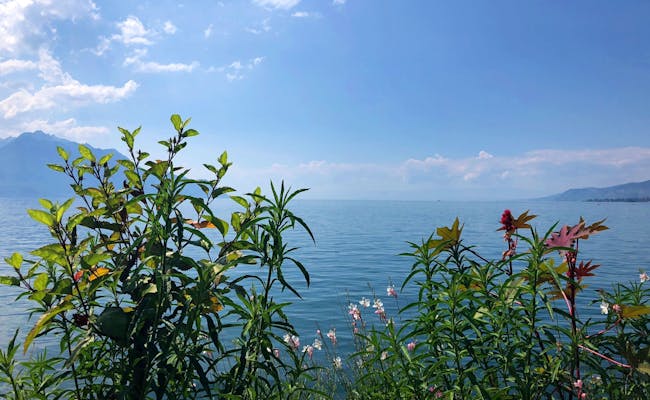
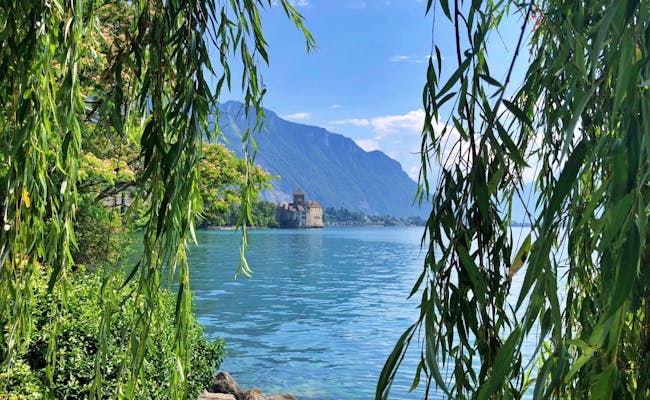
Today you have the whole day to explore Bern. After breakfast, you can either join a city tour or set off on your own. Stroll through the old town, visit the Bear Park, check out the Federal Palace, and walk back to the Rose Garden to enjoy the view.
You can also visit the Gurten - Bern's local mountain, observe the animals at the Dählhölzli Zoo, or check out the Botanical Garden. Take the lift from the train station and enjoy the view from the Grosse Schanze or go for a swim in the Aare or at Weyermannshaus.
Oh, the options…
When you're ready to leave Bern, hop on the train back to Zurich. Or if you're departing from Geneva, you can head in that direction too.
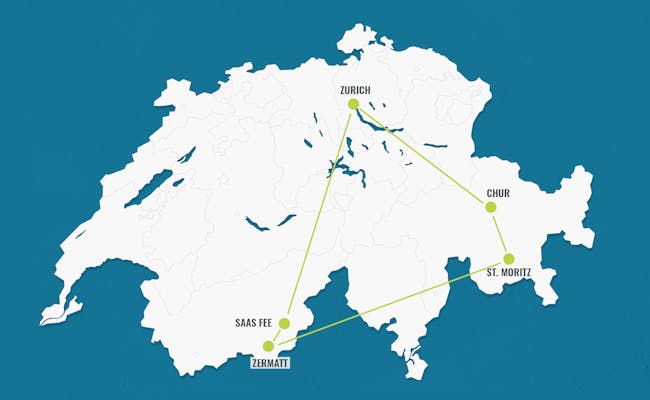
Highlights on this itinerary:
Explore Zurich on your own in the morning, rent a free bike with «Züri rollt» or join a city tour. After the tour, you can grab a takeaway lunch and enjoy it on the train to Saas-Fee.
Saas-Fee, also known as the “Pearl of the Alps”, is surrounded by the highest mountains in Switzerland. When you arrive in this charming Alpine village, you’ll find yourself surrounded by 13 mountains, all of which rise over 4,000 meters above sea level.
Spend the afternoon strolling through the village and try to acclimatize to the thin mountain air up here. If you're eager to get going now, you can find some ideas in tomorrow's overview.
Get ready to breathe in the fresh mountain air that you'll enjoy all day long. You're likely to spend most of your time outdoors. If you visit in the summer, you'll find countless hiking opportunities. Over 350 kilometers of hiking trails will take you to places you never knew existed.
And while you're at it, don't forget to keep an eye out for marmots during your hike. Your chances of spotting a few of these cute alpine residents are pretty good here.
But Saas-Fee isn't only interesting during the hiking season. If you're here in winter, you can really let loose skiing or snowboarding. And because Saas-Fee is so high up, you'll be skiing on a glacier part of the time. That's not something you get to experience every day.
Over 150 kilometers of groomed slopes are available for as long as you want. While other ski resorts have struggled with snow shortages in recent years due to climate change, Saas-Fee boasts a high level of snow reliability thanks to its elevation.
Enjoy the views of the mountains, the snow, the hikes, the marmots, and the fresh air. In the evening, take the post bus and the train to Zermatt.
Once you arrive in Zermatt, you can spend the rest of the day strolling through the famous resort and taking in the view of the iconic Matterhorn, assuming it's not shrouded in clouds.
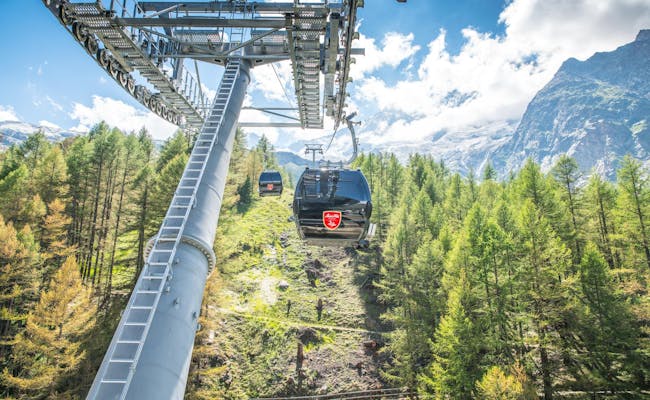

Zermatt is all about the mountains and nature. If you came to Switzerland for the breathtaking views of the mountains, you'll absolutely love it here.
Countless hikes and walks of all difficulty levels will take you to places that will leave you speechless. For example, the popular Zermatt 5-Lakes Walk, which takes about 2.5 hours. It leads past five crystal-clear mountain lakes and offers stunning views of the Matterhorn along the way.
Another adventure that might leave you a bit dizzy is crossing the world’s longest pedestrian suspension bridge in Randa. It stretches a remarkable 494 m across the valley. The round trip to the bridge starts and ends in Randa, just 15 minutes by train from Zermatt.
If you'd rather skip the hike and see the mountains easily, I recommend taking the train up to Gornergrat. After an incredibly steep train ride, you'll find yourself at an altitude of 3089 m above sea level, right in front of the Gorner Glacier and the Matterhorn. Don't be surprised if you find yourself out of breath climbing the steps to the viewpoint—that's not on you, but due to the thin air.
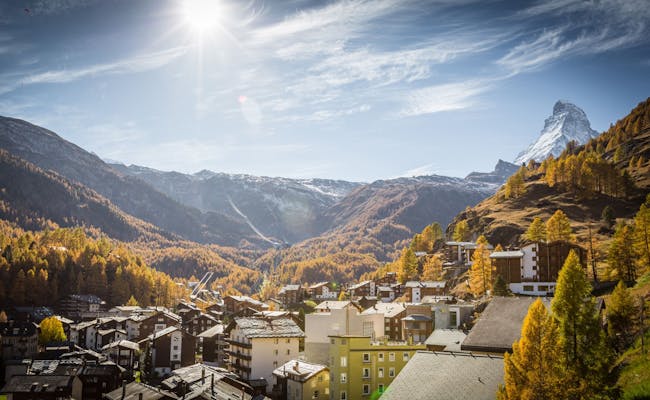
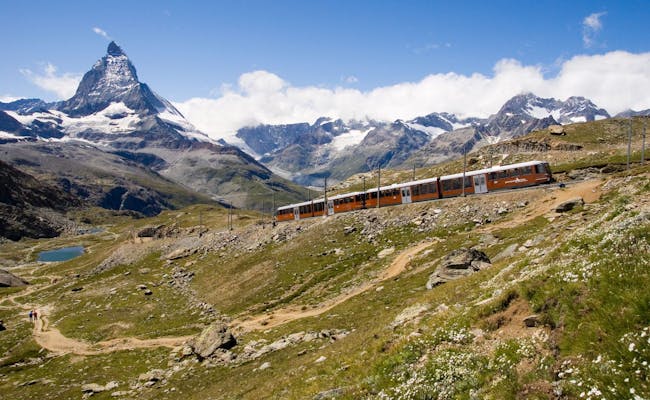
Today, you’ll be taking the Glacier Express from Zermatt to St. Moritz. This journey on the "slowest fast train in the world" is a unique experience. Throughout the trip, you’ll be treated to some of the best views the Alps have to offer.
The train leaves Zermatt twice daily in the morning. The schedule changes throughout the year, and there are some trains that don’t run the entire route between Zermatt and St. Moritz. To find your connection, check the current timetable in advance.
There’s a reason the Glacier Express is one of the most popular train routes in Switzerland. What makes this trip unforgettable are the fantastic views that accompany you along the way. The train will take you over 291 bridges, through 91 tunnels, across two provinces and two language regions.
The ride lasts a little over 8 hours, and depending on when you leave Zermatt, you’ll arrive in St. Moritz between 5:00 PM and 6:00 PM.
Once you arrive, you can spend the rest of the day strolling through this chic mountain village in the Engadin.
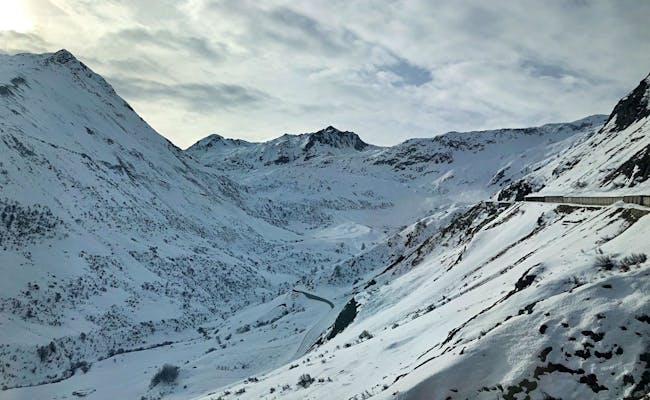
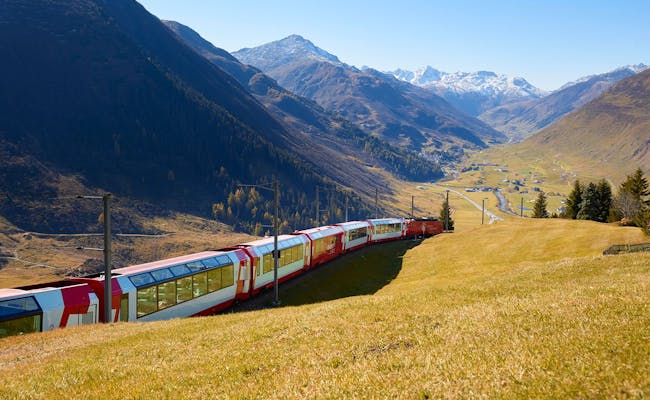
As in Zermatt and Saas-Fee, outdoor experiences are the focus in St. Moritz. Whether it's cycling, hiking, stand-up paddling, swimming, windsurfing, skiing, snowboarding, snowshoeing, cross-country skiing, or just a leisurely walk, you'll find everything your heart desires here.
Just a short ride from St. Moritz is Lake Silvaplana. It's a stunning spot to engage in some of these activities.
Another place worth visiting is Ospizio Bernina. At 2,253 meters above sea level, this small station is the highest point on the Bernina Express scenic train. Trains depart hourly from St. Moritz and take you past lakes, glaciers, and towering mountain peaks.
On the culinary side, I recommend two things in the Engadin. First, you shouldn't miss a bowl of Bündner barley soup. This soup, made with barley, vegetables, and meat, is a typical dish from the region and warms you up on a chilly day like nothing else.
Secondly, treat yourself to a slice of Engadine nut cake. This rich, delicious pastry brings back the calories exactly where you wanted to lose them. But it's definitely worth it.
Back in St. Moritz, you can spend the rest of the day strolling through the town. St. Moritz isn’t quite as charming and mystical as other villages in the area, like Samedan or La Punt, but it’s great for window shopping. And if you’re lucky, you might even spot a celebrity or two.
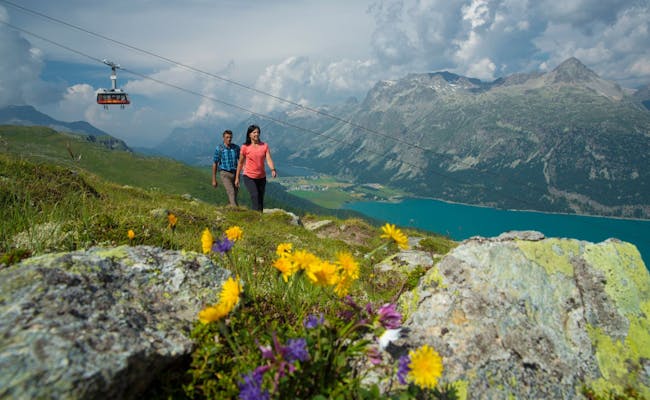

If there’s anything you didn’t get to do yesterday, today’s your chance. The train ride back to Zurich takes just over three hours so there’s no rush to leave just yet.
However, if you’ve seen it all and you’re ready to move on, you’re welcome to hop on the train and spend some time anywhere along the way between St. Moritz and Zurich.
One place you might like is the dreamy village of Bergün with its impressive stone buildings that are iconic to this area.
You’ll arrive in Bergün right after navigating the confusing Albula Line, the part where the train overcomes the altitude by taking a few loops and tunnels through the mountains. As you look out the window, you’ll notice the train crosses sides of the valley while spiralling down the mountains.
Another place you might enjoy between St. Moritz and Zurich is Walenstadt. Or more precisely, Lake Walensee. This beautiful lake is the perfect stopover. It’s a stunning and mystical lake and, depending on the weather and the light reflection, it sometimes reminds you of a Scottish loch.
Spend the rest of the evening in Zurich and snack on some more Engadiner Nusstorte by the lakeshore or at Lindenhof.
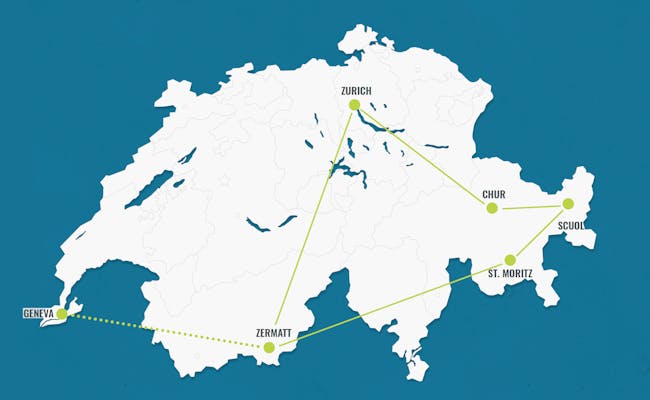
Highlights on this itinerary:
Explore Zürich in the morning at your own pace, rent a free bike with "Züri rollt" or join a guided city tour. After the tour, you can grab a takeaway lunch and enjoy it on the train to Chur.
For a better view of Lake Zürich and Lake Walensee on your way to Chur, try to get a seat on the left side of the train. Spend an hour or two wandering through Chur and get ready for the fresh mountain air that awaits you in Scuol.
Before heading to Scuol, you can visit two of Switzerland's most beautiful mountain lakes, both located near Chur: Lake Cauma and Lake Cresta. These picturesque lakes are popular with both locals and visitors.
Another fantastic spot in the area is Ruinaulta, the stunning Rhine Gorge. This UNESCO World Heritage site is aptly nicknamed the "Swiss Grand Canyon".
There’s a hike that connects Ruinaulta with Lake Cauma and Lake Cresta. This easy 2.5-hour hike starts at the postbus stop Flims Waldhaus. Depending on how much time you've spent in Zürich and Chur today, you might even be able to complete the entire hike.
When you’re ready, head back to Chur and hop on the train to Scuol.
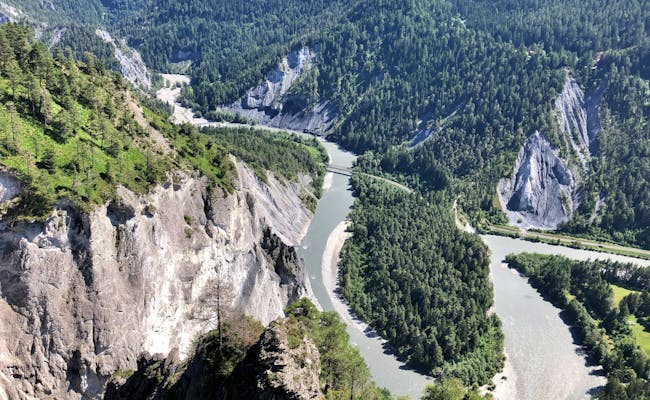
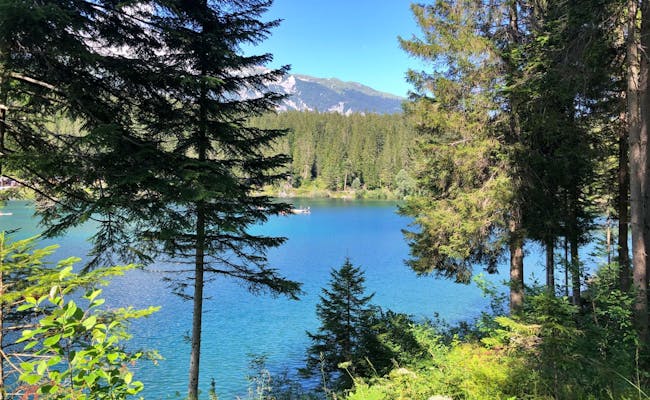
The Engadin has to be one of the most magical places in Switzerland. Especially during autumn, when the leaves turn yellow, orange and red. But throughout the rest of the year, it’s just as fantastic a place to visit.
For organisational purposes, it makes sense to head into the National Park first thing in the morning and come back for Scuol later. If you ask nicely, they might let you leave your luggage at your accommodation in Scuol until you come back from the mountains tomorrow night.
The rules that apply when visiting Switzerland’s only National Park are pretty strict. There’s no leaving the marked trails, no taking plants with you, no making fires and so on. Once you arrive at the gates of the park, please read the signs or stop by the visitor centre in Zernez to make sure you’re prepared.
What you probably weren’t expecting is that visiting the park is free. Everything in Switzerland seems to be more expensive than anywhere else in the world. And yet, while you pay an entrance fee to pretty much every National Park in the world, ours is free. Pretty cool, right?
Since the only place to spend the night inside the Swiss National Park is a mountain hut called Chamanna Cluozza, you’ve got one task to accomplish today. Get to Chamanna Cluozza.
One hike I recommend starts half an hour from Scuol, in the village of Zernez. From there, you’ll spend a good three hours until you reach your camp for the night. The hike isn’t too straining. And if you’re not the most experienced hiker, just give yourself enough time and you should be alright.
Enjoy this evening far away from civilisation without phone reception and sitting around a table chatting to strangers. You’ve earned it.

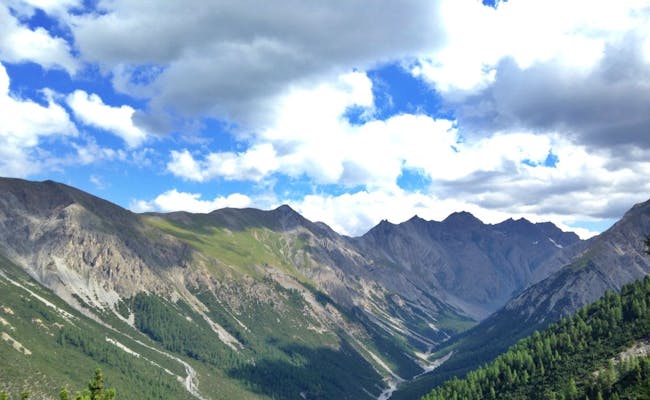
If you haven't planned today's hike yet, ask the owners of Chamanna Cluozza for their recommendations. There are plenty of other hikes available with varying levels of difficulty. This gives you another day to explore the national park.
Alternatively, you can head back to Scuol right after breakfast if you've had enough hiking. The choice is entirely yours. If you're looking for a relaxing alternative, the Engadine is the perfect place.
On one hand, there’s the thermal bath in Scuol. Depending on how sore your feet are from yesterday's hike, a few relaxing hours in the hot springs might be just what you need.
Otherwise, I recommend visiting one of the surrounding villages, like Guarda or Sent. The stone houses you see there are typical of this part of Switzerland.
And as you pass by these impressive buildings, keep an eye out for a bakery. The famous Engadine nut cake comes from the Engadine. If you have a sweet tooth, you definitely need to try a piece or two. This cake is quite dense and rich, but every single calorie is worth it.
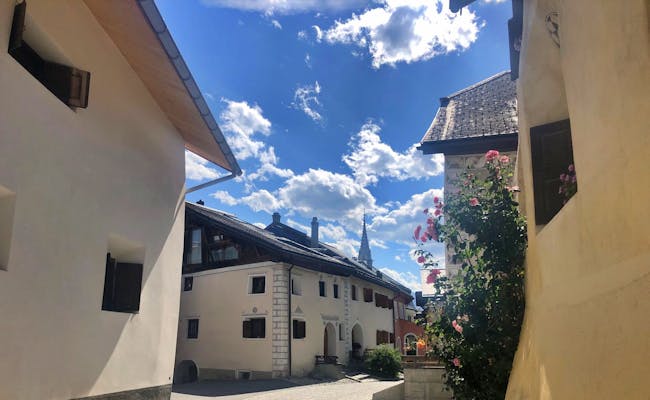

After breakfast, you leave Scuol and head to St. Moritz. You have the entire day to explore this chic holiday resort. It's all about outdoor experiences here, whether in summer or winter. Whether it's cycling, hiking, stand-up paddling, swimming, windsurfing, skiing, snowboarding, snowshoeing, cross-country skiing, or just taking a walk, you'll find everything your heart desires.
Just a short drive from St. Moritz is Lake Silvaplana. It's a stunning spot to enjoy some of these activities.
Another must-visit place is Ospizio Bernina. At 2,253 meters above sea level, this small station is the highest point of the Bernina Express panoramic train. Trains depart hourly from St. Moritz, taking you past lakes, glaciers, and towering mountain peaks.
For a taste of the local cuisine, I recommend trying another dish alongside the Engadine nut cake: a bowl of Bündner barley soup. This hearty soup made with barley, vegetables, and meat is a typical dish from Grisons. It warms you up on a chilly day like nothing else.
Back in St. Moritz, you can spend the rest of the day strolling through the town or relaxing by the lake. St. Moritz may not be as charming and mystical as other villages in the area, like Samedan or La Punt, but it’s great for some window shopping. If you're lucky, you might even spot a celebrity or two.
Today, you’ll be taking the Glacier Express from St. Moritz to Zermatt. This ride on the "slowest express train in the world" is a unique experience. Throughout the entire journey, you’ll enjoy some of the best views the Alps have to offer.
The train departs St. Moritz twice daily in the morning. The schedule changes throughout the year, and some trains do not run the entire route between St. Moritz and Zermatt. To find your connection, make sure to check the current timetable in advance.
There’s a reason why the Glacier Express is one of the most popular rail routes in Switzerland. What makes this journey so unforgettable are the fantastic views that accompany you throughout the ride. The train takes you across 291 bridges, through 91 tunnels, across two cantons and two language regions.
The journey takes just over 8 hours, and depending on when you leave St. Moritz, you’ll arrive in Zermatt between 5:00 PM and 6:00 PM. Once you arrive, you can spend the rest of the day strolling through the charming mountain town and enjoying the sight of the majestic Matterhorn.
Assuming it’s not shrouded in clouds.
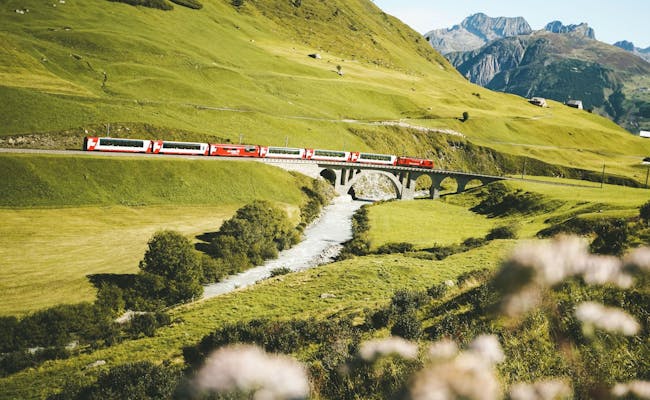
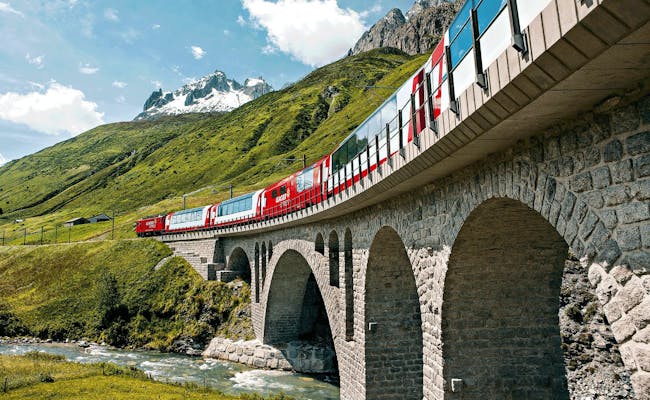
Like St. Moritz, Zermatt is all about mountains and the outdoors. If you’ve come to Switzerland for our spectacular mountain views, you’re going to love it here. Several hikes and walks of all difficulty levels take you places you didn’t even know existed.
Luckily, you’ve got all day to explore this stunning mountain town today. For a complete rundown of things to do in and around Zermatt, turn back to itinerary No. 6 on day 3.
Once you’re ready to leave the alpine air, catch the train to Zurich. Or, if you’re flying out of Geneva or planning on visiting Switzerland’s second largest city, you can head in that direction instead.

Highlights on this itinerary:
(Just a heads up: This itinerary is seriously jam-packed and I don’t necessarily recommend following such a tight schedule. However, it is doable in six full days and if you’re the “I-need-to-see-as-much-as-humanly-possible” kind of person, feel free to knock yourself out.)
In the morning, explore Zurich on your own, borrow a free bike with «Züri rollt» or join a guided city tour. After the tour, grab some take-away lunch and have it on the train to Schaffhausen.
Head straight to Neuhausen next to Schaffhausen, where the mighty Rhine Falls attract visitors from all over the world. Access to the falls is free from the northern shore, while seeing them from Laufen Castle in the south costs 5 CHF. Spend however long you like getting soaked in the mist of the Rhine Falls before moving on to Schaffhausen.
Schaffhausen has a charming old town with an impressive total of 171 bay windows, which is more than any other Swiss city can account for. Once you’re done chasing them all down and exploring the rest of Schaffhausen, head up to Munot and enjoy the view over the city.

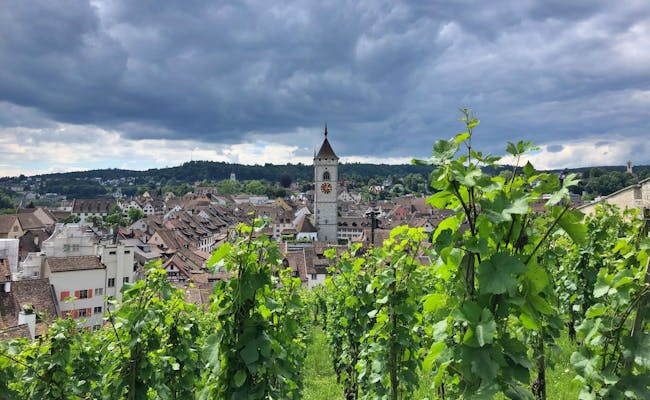
After breakfast, you’ll pack your bags and take the train to St. Gallen. You have the whole day to explore the city and its surroundings in all their glory.
With its UNESCO World Heritage-listed Abbey District, impressive cathedral, and stunning Abbey Library, this city has a lot to offer.
Don't miss the recreational area “Drei Weieren”. You can get there either via the Mühleggbahn or by walking up one of the many staircases. Alternatively, you can also visit the Peter & Paul Wildlife Park or quench your cultural thirst in one of the many museums.
The best spot to relax is definitely the “Drei Weieren”. Here, you can go swimming or take a walk through the woods. Plus, you have a fantastic view over the whole city, Lake Constance, and even as far as Germany.
Lake Constance, the Appenzellerland, and the Alpstein mountains aren’t far from St. Gallen either. If you want to visit any of these places, you’ll have plenty of time to do so in the afternoon. A detailed list of activities in the Alpstein or around Lake Constance can be found in itinerary number 4.

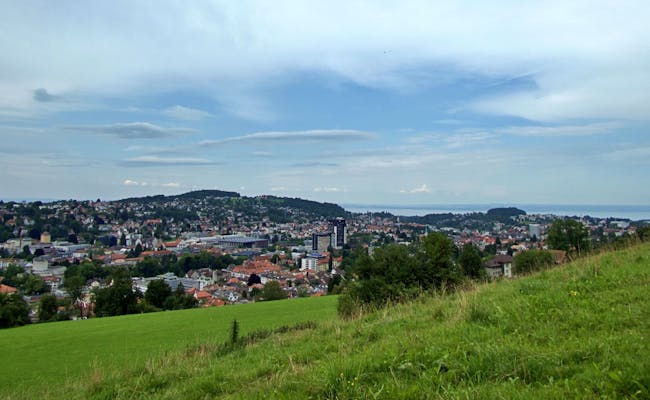
Today you've got quite a bit ahead of you, so leave St. Gallen early in the morning and hop on the Voralpen Express heading towards Lucerne. The Voralpen Express takes you through very picturesque landscapes and takes just over two hours to reach Lucerne.
Of the many scenic train journeys in Switzerland, this one is significantly less touristy. There are no big panoramic windows and no friendly voice telling you which viaduct you’re currently crossing.
But that doesn’t make the ride any less worthwhile.
I recommend breaking up your trip halfway and getting off in Rapperswil. This town is a hidden gem at the lower end of Lake Zurich. Visit the castle, spend some time with the deer in the castle garden, swim in Lake Zurich, and stroll along the picturesque lakeside promenade.
A great place to relax is the meadow behind the OST, the University of Applied Sciences in Rapperswil. You can't miss it when you walk from the train station towards the lake.
If you want to take a leisurely walk, follow the wooden walkway and the connecting bridge over the lake to Pfäffikon. In doing so, you’ll cover three kilometers of the Camino de Santiago, a pilgrimage route that leads from various places in Europe to Santiago de Compostela in Spain.
When you’re ready to continue, hop on the next train to Lucerne and spend the afternoon exploring the city. Walk across the Chapel Bridge, wander through the old town, linger by the lake, or visit the Glacier Garden with its famous Lion Monument.
You’ll find a detailed list of activities in Lucerne on Day 2 in Itinerary No. 3.
In the late afternoon, take the Golden Pass Line, another popular train route, to Interlaken. It connects the center of Switzerland with the shores of Lake Geneva.
This panoramic route passes eight lakes, crosses through six different cantons, over three mountain passes, and connects two language regions. The leg between Lucerne and Interlaken is operated by the Zentralbahn and takes just under two hours.
Spend the rest of the day in Interlaken, a popular and heavily touristed town. There are countless activities here, and if you want to fully enjoy this region, one night isn’t enough. Unfortunately, you’ll only get a brief impression of Interlaken, since you won’t have time to explore the area tomorrow. But there should be enough time for a stroll along the Aare or a quick trip up to Harder Kulm.


Today, you can look forward to another scenic delight. As you leave Interlaken and head towards Zweisimmen, you'll have Lake Thun on your right. To get the best view of the lake, I recommend snagging a seat on the right side of the train.
If time allows and you don't mind taking a little break, consider making a quick stop in Spiez. With its castle, charming vineyards, and direct access to Lake Thun, Spiez is definitely worth a visit.
Continuing your journey, you'll need to transfer to another train in Zweisimmen. This is where the climb through the Bernese Oberland begins, heading towards Gstaad. This area is a dream come true for mountain lovers and perfectly encapsulates what Switzerland has to offer. There are lakes, mountains, lush meadows with grazing cows, glaciers, plenty of hiking trails, stunning landscapes, and quaint little villages in abundance here.
Even if you don’t have time to stop along the way, the ride through this picturesque region is something you’re likely to remember for a long time.
Once you leave the Bernese Oberland and have descended the hills, you will arrive in the French-speaking part of Switzerland. Before heading to Lausanne, you’ll have a few hours to explore Montreux.
Head to the lakeside promenade and check out the Freddie Mercury statue in front of the market hall. If you want to visit the famous Château de Chillon, you can either follow the promenade all the way to the castle or hop on a bus. There are also passenger boats that regularly operate between Montreux and Château de Chillon.
Alternatively, you could head straight to Lausanne, drop off your bags, and visit the renowned Lavaux vineyards, which are a UNESCO World Heritage site. To enjoy the stunning views, get off in Cully or Epesses and follow the marked hiking path through the vines.

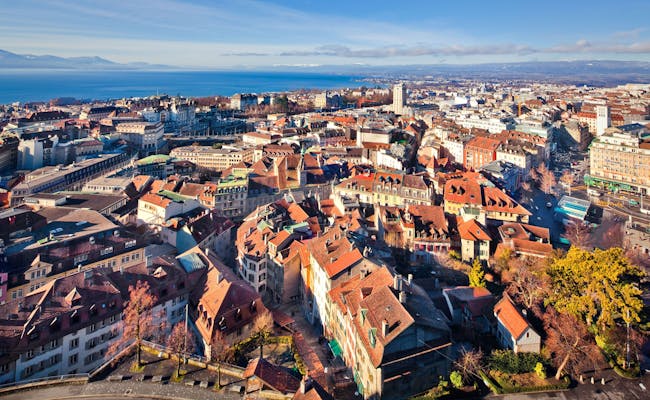
Spend the morning exploring more of Lausanne. The picturesque old town of Lausanne is built on three hills and surrounded by numerous vineyards. It is home to the International Olympic Committee and the only metro system in Switzerland.
If you wanted to visit the Lavaux vineyards yesterday but ran out of time, you have another chance to try today.
Around noon, you’ll leave Lausanne and head to Bern, the capital of Switzerland. You’ll have the whole afternoon to explore the city before continuing to Basel for the night. Stroll through the old town, visit the Bear Park, check out the Federal Palace, and walk back to the Rose Garden to enjoy the view.
You can also visit the Gurten – Bern’s local mountain – watch the animals at the Dählhölzli Zoo, or explore the Botanical Garden. Take the lift at the train station and enjoy the view from the Grosse Schanze, or go swimming in the Aare or at Weyermannshaus.
Make sure to use your time wisely, as half a day won't be enough to see everything. At the end of the day, you can take the train to Basel and spend the evening in the city or by the Rhine.
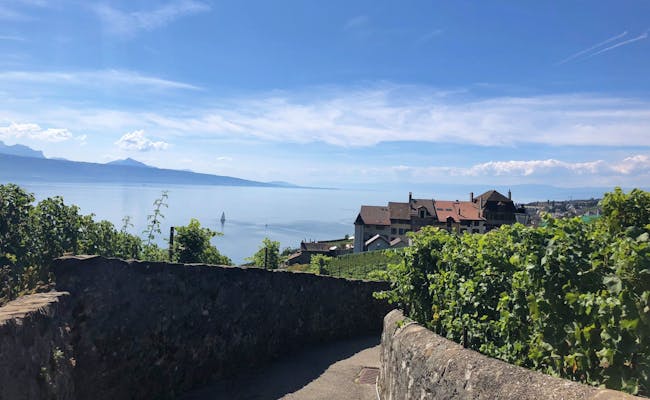

Basel is a vibrant city right on the German-French border. You'll find several city tours at various times. You can either join a tour or set off to explore the city on your own.
Stop by the Pfalz - the perfect viewpoint for taking some postcard-worthy photos - stroll along the Rhine and watch the large cargo ships coming in and out of the port. Walk past the cathedral or check out one of the many museums.
In the warmer summer months, you can join the locals for a swim in the Rhine. Before jumping in and letting the current carry them downstream, they put their clothes in a Wickelfisch. This dry bag shaped like a fish is a Basel icon.
Alternatively, you can hop over the border to visit Weil am Rhein in Germany or Saint-Louis in France. Theoretically, you can even visit all three countries in one day—Switzerland, Germany, and France. It’s definitely doable in Basel and something you might not experience every day, especially if you come from a country where you need to fly to reach the next border within a reasonable time.
When you're ready to leave Basel, head back to Zurich and spend the rest of the day exploring Switzerland's largest city.
And congratulations! You've just completed what I think is the craziest trip through Switzerland. I don't think you could have made the most out of your time here. I hope you enjoyed it.


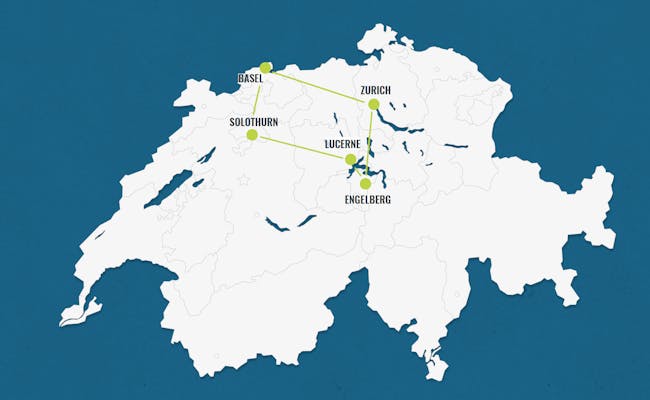
Highlights on this itinerary:
Explore Zürich independently in the morning, borrow a free bike with "Züri rollt" or join a city tour. After the tour, grab a take-away lunch and take the train to Engelberg.
This diverse mountain village is located about 25 km south of Lake Lucerne at an elevation of 1013 m above sea level. Towering at 3239 m above sea level, the mighty Titlis overshadows the other peaks around Engelberg.
Since you'll arrive in Engelberg in the mid to late afternoon, there won’t be enough time to head up immediately. So let’s save that for tomorrow so you don’t feel rushed.
Instead, you can spend the afternoon exploring the center of Engelberg, or more specifically, the Benedictine Monastery. This old monastery was founded in 1120 and is still home to about 20 monks. You can either visit it on your own or join a guided tour.
Like many places in the Swiss Alps, Engelberg focuses on outdoor activities. The most popular destination in the area is undoubtedly Titlis. From Engelberg, you can reach the summit with two gondolas. One of them is the Rotair, the first aerial cable car in the world that rotates 360°. At the summit, you’ll be greeted by an impressive panoramic view. Additionally, there’s a spectacular glacier cave and the exciting Titlis Cliff Walk by Tissot.
The hiking options in Engelberg are virtually endless, offering something for everyone. A highly recommended hike is the "Kitzelpfad" in Brunni. Here, you take off your shoes and walk over various types of ground. And while your feet are tickled by nature, you can also enjoy a perfect view of Titlis.
And what would a proper hike be without one or two mountain lakes…?
A somewhat more challenging hike called the Four Lakes Hike takes you past – as you may have guessed – four mountain lakes. Since this hike takes almost five hours, I recommend it only if you feel fit enough.
If you want a less strenuous day, you can choose the wheelchair-accessible path around Engelberg. This two-hour hike starts at the monastery in the center of Engelberg and leads to the picturesque Aa River and back. Even though you won’t be reaching the summits on this hike, you’ll still have a lovely view of the mountains.
In winter, Engelberg turns into a true paradise for snow lovers. Whether you enjoy skiing, snowboarding, snowshoeing, hiking, cross-country skiing, ice skating, or tobogganing, you’ll be able to meet your expectations. Engelberg is particularly popular among freeriders.
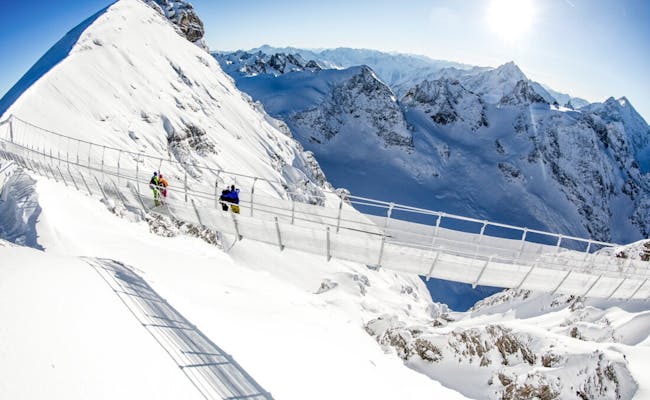

If there’s anything you wanted to do in Engelberg yesterday but ran out of time, get that over with in the morning and leave for Lucerne whenever you’re ready.
Travelling from Engelberg to Lucerne takes less than an hour on the train and is very straightforward. Once you arrive, store your bags at the train station and spend a few hours exploring this charming city. Walk across the Kapellbrücke, take a stroll through the old town, hang out by the lake or visit the Glacier Garden with its famous Lion Monument.
You’ve got all afternoon here, so take your time. For more ideas of things to do in Lucerne, turn to itinerary No. 2 on day 5. Once you’ve seen enough of Lucerne, move on to Solothurn, which is commonly known as Switzerland’s most beautiful baroque city. With its impressive baroque cathedral and the many hidden and pretty alleyways, the city has earned this title with no doubt.
You probably won’t have too much time to discover Solothurn tonight. So just treat yourself to a few scoops of ice cream at Vitaminstation – one of the ice cream places ever – and have it while sitting on the stone wall along the River Aare.
You’ll fit right in with the locals in doing so.
Seraina’s Tip: My two absolute favourite places for food in Solothurn are Pittaria and Vitaminstation. Anyone that likes a good falafel or hummus is going to love Pittaria. And Vitaminstation makes some of the best ice cream I’ve ever tasted in Switzerland.
Although Solothurn is by no means a big city, there’s still plenty to see and do in the area. One activity I particularly recommend is going on a hike in the Jura mountains. This high plateau is a wonderful area to visit all year round.
One option to reach the top with its countless walking trails is by cable car from Oberdorf to Weissenstein. Feel free to walk as long and as far as you like before hiking back down or catching the cable car to Oberdorf.
A very popular hike is the round trip from Solothurn via Balmberg and Weissenstein. Catch the Postauto in Solothurn, get off at Balmberg, walk along the crest to Weissenstein and head back down to Oberdorf by cable car. From Oberdorf, the train will take you back to Solothurn.
This is an easy walk and takes you into the Jura without too much effort. During your hike, you’ll also enjoy the view over the Alps, including Eiger, Mönch and Jungfrau.
Another place you can visit is Verena Gorge. You can walk along the creek through the forest in the gorge until you reach the little hermitage at the end. The walk takes roughly 45 minutes return and is super peaceful.
Alternatively, hop on the passenger ship to Biel. How long you stay on it really depends on your preferences. You can go all the way to Biel – which takes around three hours – or get off anywhere along the way and catch the train back to Solothurn.
One of the highlights on this tour will be Switzerland’s largest stork station in Altreu, which you’ll pass about 45 minutes into the journey. In 1950, when storks were nearly extinct in Switzerland, Max Bloesch started his reintroduction project to save our storks. Thanks to him, around 40 breeding pairs can be seen soaring through the air, strutting across the fields and clattering on the rooftops around Altreu these days.
Only in spring and summer, though. They travel to warmer territories in autumn until winter is over.
If you continue your journey onward to Biel, the views of the Jura mountains and the Swiss Central Plateau will accompany you all the way. After passing through a watergate, you’ll arrive at the port in Biel, which is only a short walk from the train station.
From there, heading back to Solothurn will take 15 minutes by train.
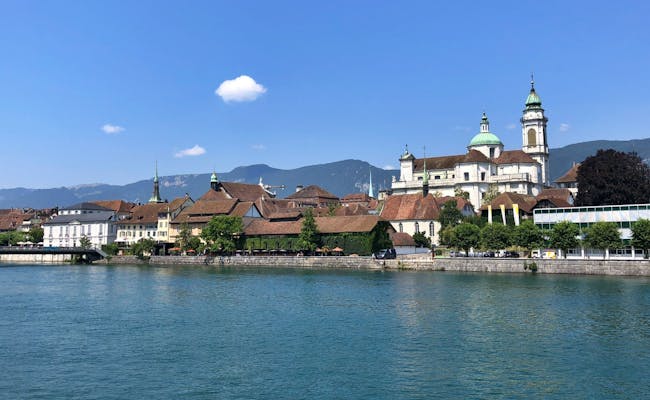
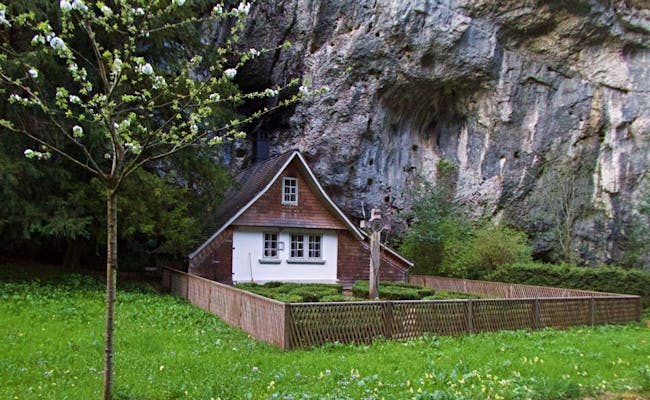
If you need a bit more time in Solothurn this morning, feel free to stay a little longer. Once you're ready, hop on the train to Basel. The train ride takes just an hour.
Basel is a vibrant city located right on the German-French border. You'll find several city tours at various times. You can either join a guided tour or explore the city on your own.
Stop by the Pfalz - the perfect viewpoint for taking some postcard-worthy photos - stroll along the Rhine, and watch the large cargo ships coming in and out of the harbor. Pass by the Cathedral or check out one of the many museums.
In the warmer summer months, you can join the locals for a swim in the Rhine. Before diving in and letting the current carry you downstream, they wrap their clothes in a Wickelfisch. This dry bag, shaped like a fish, is a symbol of Basel.
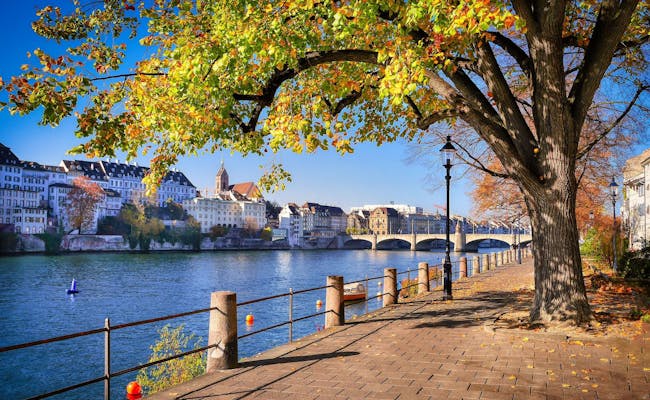

If there’s something you wanted to see in Basel yesterday but didn’t get the chance, today’s your day. However, if you’ve already taken in enough of the city, you can always hop across the border to visit Weil am Rhein in Germany or St. Louis in France.
Theoretically, you can even visit all three countries in one day: Switzerland, Germany, and France. This is quite doable in Basel, and it’s an experience you might not have every day, especially if you come from a place where you have to catch a flight to reach the next border in a reasonable time.
When you’re ready to leave Basel, head back to Zürich and spend the rest of the day exploring the largest city in Switzerland. If time permits, you can wrap up this itinerary with a visit to the Lindt chocolate factory.
Not far from Zürich, in Kilchberg, you’ll find the brand-new Lindt Visitor Center, which opened its doors to the public in September 2020. If you’ve never tried a roasted cocoa bean, eaten as many Lindor truffles as you can, or spent some time by the tallest chocolate fountain in the world, this is your chance.
And this concludes our collection of three-day itineraries for Switzerland starting in Zurich. We hope you’ve been able to find the Switzerland itinerary to your taste. Have fun planning your trip.
